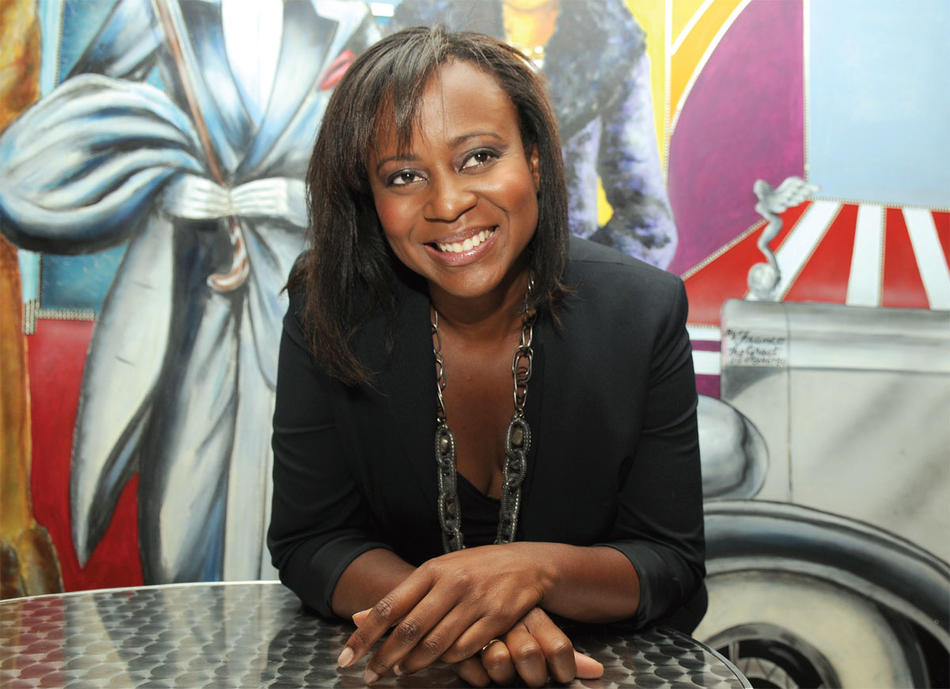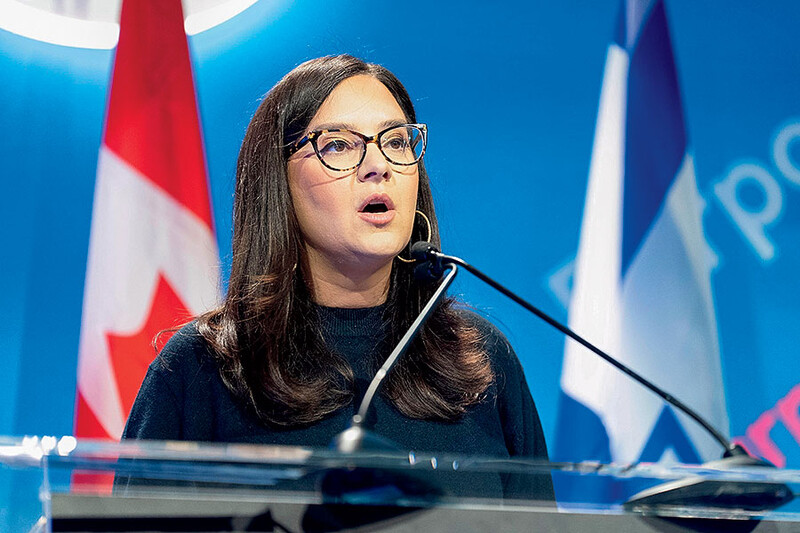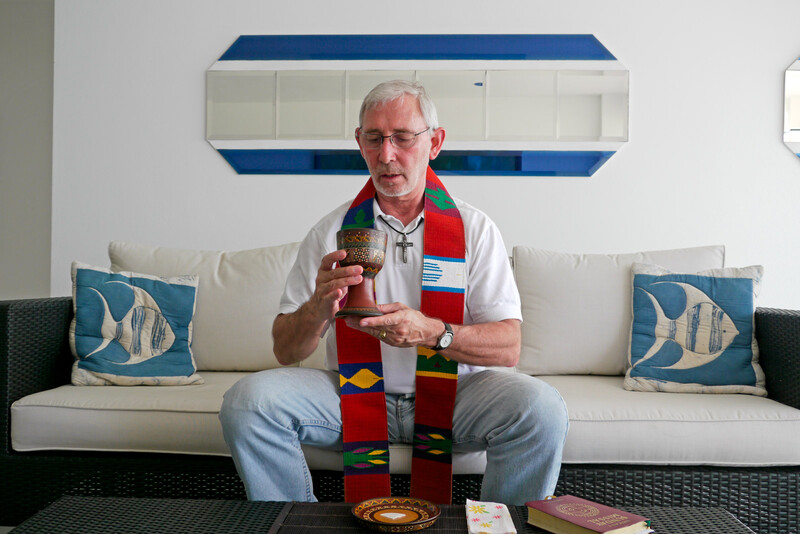
Friday night at Harlem Lanes. The house lights are down, the disco lights spin and flash. You select a ball — a medium, orange, 10 pounds, plenty of heft after a long work week. The pins, eggshell-white by day, glow in the darkness like elongated lightbulbs. The lane markers, tiny arrows, are a faint Day-Glo purple. The gutters are illuminated like the edge of an airport runway. You might be preparing to board the mothership.
Over the sound system, Frankie Beverly and Maze perform “Before I Let Go.” Classic old school. To your surprise, the early-20-somethings in the next lane know all the words. They sing along, as does, a little less tunefully, the contingent of gay white men up from Hell’s Kitchen on lane 17. On 18, a crowd of birthday celebrants — it appears to be at least a 40th birthday — cheers as the guest of honor, with a coaxing swivel of her hips, converts a 2-7 split. And above it all, the essential music of the place: the thud of lofted balls, the low thunder of the roll, and pins exploding in a satisfying chunk of sound.
You feel it in your gut, that clatter. There’s something vital about the wooden pock of struck pins; it harkens back to ancient games, the smashing of idols, social ritual. You haven’t bowled since the Clinton era, but it’s reassuring to think that people have been doing it, in one form or another, for thousands of years. They were doing it in Harlem, too, until 30 years ago, when Lenox Lanes, like the old Harlem Lanes before it, closed its doors.
“Stay out of the ditch!” your friend calls as you line up your shot. “Hook it to the pocket!” He’s an experienced bowler and knows the lingo.
You make your approach, swinging back your arm. Then you arc it forward and release. The ball drops, rolls, and veers, with a kind of cruel, mocking intelligence, into the gutter.
“Too much torque,” says your friend, who has a familiarity with physics.
A moment later, a young, slender woman next to you stands at the foul line holding a green ball with both hands. She bends over and heaves the orb from between her knees. You watch as it rolls slowly, in perfect accordance with Newton’s laws, down the middle of the lane. Amazingly, and in something like slow motion, all of the pins topple. The bowler raises her hands and does a slinky victory dance as her boyfriend stands there open-mouthed. “3 Peat” by Lil Wayne comes on. Your orange ball returns, and you grab it. Bowling is back in Harlem.
Early on Tuesday morning, September 11, 2001, Sharon Joseph ’97BUS kissed her infant daughter, Morgan, good-bye, and took the subway from her home in Harlem to a meeting in Midtown. Joseph was working as a strategic consultant for American Express, at Three World Financial Center on Vesey Street, and normally she traveled straight to the World Trade Center stop. When her meeting was over, she went down into the subway, only to be told by a police officer that there was no service. A plane had hit the North Tower.
Joseph would never return to the Vesey Street office. The building was heavily damaged in the attacks, and Joseph now had to commute to an office in Short Hills, New Jersey, a major inconvenience for a single mother. That December, AmEx announced that it would lay off 6500 employees. It was with some relief that Joseph accepted her severance package.
A month later, Joseph and her aunt, Gail Richards, a clinical psychologist and entrepreneur who had opened one of the first $10 shops in Harlem, were walking along West 125th Street, tossing around ideas for a business. Like many New Yorkers, Joseph and Richards were profoundly shaken by the events of September 11, and had begun to think more about their families and, by extension, their community. And their community was changing — dramatically. Richards had foreseen what Columbia professors Neil Smith and Richard Schaffer, in their seminal 1986 paper “The Gentrification of Harlem?,” identified as an incipient pattern of black gentrification in the area. In the 1990s, Richards bought a Harlem brownstone and started dealing in real estate. Now, in 2002, 125th Street, long depressed economically, was home to a new Starbucks and a retail complex called Harlem USA that housed, among others, an Old Navy, a Disney Store, and the nine-screen Magic Johnson Theatres. Ambitious plans for hotels, luxury housing, office space, banks, and more box stores like Marshall’s and HMV were in the pipeline. The frenzy had begun.
Observing the commerce on Harlem’s shopping strip, Joseph saw an opportunity not only to capitalize on the multibillion-dollar buying power of the over 200,000-strong Harlem community, but to establish a local bulwark against the tide of national chains that was driving out small businesses and street peddlers. As a consultant, Joseph would ask clients, “What’s the problem that you’re going to need us to solve?” For Harlem, as Joseph saw it, the problem was a lack of services, especially for families. A sports enthusiast, Joseph wanted to come up with a family-friendly activity that was neither gender nor age specific, was affordable, and encouraged social interaction. The family that plays together stays together.
But what could they play?
Basketball? Hard to picture grandma crashing the boards. Tennis? Not for a family of five. Joseph then recalled an item she’d read a couple of years before about Microsoft veteran Chris Peters, who had purchased the Professional Bowlers Association. “I’m a Wall Street person, so I follow trends,” Joseph said recently in her Harlem Lanes office. “Watching Peters, I knew that bowling was definitely something people were interested in.” The sport seemed to meet her criteria for family fun, but would it be a good fit for Harlem?
To find out, Joseph and Richards interviewed passersby on 125th Street, visited bowling alleys from Port Authority to New Rochelle, and handed out questionnaires. To their surprise, many of the customers at those far-flung lanes were Harlemites.
Joseph was convinced that bowling was the answer. Now she and Richards would need funding; Joseph estimated that it would take $2 million.
Despite their advanced degrees and professional success, the women were unable to get a bank loan. Joseph was deeply discouraged, though she had been down that road before. Back in 1997, Joseph, as part of the Columbia Business School’s Entrepreneurship Program, devised a business plan for a local basketball and health club. One of her professors, Clifford Schorer, had gone around town with her to look for funding. They had no luck, but Joseph never forgot the support she received from Schorer and Columbia.
Now, with an unquenched yearning to do something meaningful for the community, she contacted Eugene Lang ’40BUS, the philanthropist and founding donor of the Entrepreneurship Program, which offers a range of courses that emphasize personal initiative and identifying and capturing opportunity. In 1986, Lang launched the national “I Have a Dream” Foundation, which provides financial and tutorial support for the higher education of low-income students. Joseph told Lang that she wanted to volunteer for “I Have a Dream,” and mentioned that she had participated in the Entrepreneurship Program. When Lang asked her what she was doing, she told him about her idea for a bowling center.
Lang, who had attended PS 121 in East Harlem, perked up at Joseph’s pitch. He agreed to provide seed money for the project, and put Joseph in touch with “I Have a Dream” chairman Jeffrey Gural, who also was chief officer of the commercial real-estate giant Newmark Knight Frank. Gural became Joseph’s principal investor. Joseph would also receive money from the William J. Clinton Foundation’s Small Business Initiative, the New York City Investment Fund, and the Upper Manhattan Empowerment Zone (UMEZ), one of nine such zones established by the Clinton administration in 1994 to encourage private investment in economically distressed areas. (Joseph received $350,000 from UMEZ’s investment pool of $300 million, much of which has gone toward outsized projects — Harlem USA is one — that some see as squeezing out small black-owned businesses.) Joseph also received investment dollars from friends and family members.
“It was a very, very tough struggle for Sharon because it was very hard to get financing from the banks,” Cliff Schorer says. “But she never quit, she was extremely driven, and she pressed it to the hilt. I really admired her entrepreneurial spirit.”
Now Joseph needed a space — a very large space. “I’m a CU Business School person, so I don’t want to do anything small,” Joseph says. “It’s always about doing things big.” Joseph coveted the five-story, 80-year-old Blumstein’s Department Store building at 230–238 West 125th Street, with its limestone façade, green copper ornament, and early art deco interior. The building was later acquired by Touro College, and so Joseph and Richards pressed on, setting their sights on another famed location nearby, at 7th Avenue and West 126th: the old Alhambra Theater.
Opened in 1905, the Alhambra was a 1435-seat vaudeville theater (movies came a few years later); a ballroom opened upstairs in 1926 and featured talent like Bessie Smith, Jelly Roll Morton, and a singing waitress named Billie Holiday. When Joseph went to look at the cavernous space, she saw an empty shell with “a baby grand piano, a chair, and a lot of pigeons.” Light seeped in through cracks in the ceiling.
The site had potential, but the engineering challenges were enormous. A bowling alley requires open space; there is no room for support columns. In the post-9/11 climate, “structural integrity” was the buzzword for major construction projects. It took almost a year just to do surveys of the building.
“We got one of the best structural engineers in the country,” Joseph says. “The interior had to be built on the principle of a suspension bridge.”
The design called for transforming the space into two floors, each containing 12 regulation-sized bowling lanes. Downstairs there would be a snack bar with plasma televisions, a shoe rental, and an alcohol-free, family atmosphere. Upstairs, a sports bar, a mini arcade, a pool table, a party room, and a VIP lounge.
In many ways, overseeing the construction was the most challenging aspect of the venture.
“Trying to get contractors to do a job and do it within budget?” says Joseph. “Probably one of the hardest management jobs out there.” Predictably, the project ran over budget, more than doubling, to $4.7 million.
The financial pressures were considerable, especially since Joseph wasn’t working full-time.
“It was scary to give up the 9-to-5 job,” she says. “My peers were getting six-figure bonuses while I was trying to build this thing, doing odd jobs, and it was taking so long that after a while people stopped believing in me.”
By March 2006, Harlem Lanes was ready to open — well, almost ready.
Joseph explains. “We wanted Bill Clinton to do our ribbon cutting,” she says. “And everyone told us we were crazy. They said, ‘There’s no way.’ But no is just not one of those words I really understand. If someone tells me no, that just means I’m in the same place I started. So if Bill Clinton says no, then so what? But if he says yes, then I’m in a different place.” Joseph called Clinton’s office and said that as a beneficiary of Clinton’s Small Business Initiative, she would like the former president to be the major speaker at the ribbon-cutting ceremony, adding that she would happily accommodate Mr. Clinton’s schedule. Joseph was given a date of March 11 — far sooner than the pace of construction allowed. To solve the problem, Joseph hired a production company to decorate the room so it would look finished.
The ceremony, attended by Clinton, Manhattan Borough president Scott Stringer, New York congressman Charles Rangel ’87HON, and others, was covered by news outlets the world over. Historical firsts, no matter how specific, are always appealing, and Joseph and Richards quickly became known as the first African-American women in history to open a bowling alley.
Sharon Joseph grew up with her sister and mother on 152nd Street near St. Nicholas Avenue. The area, known as Sugar Hill, had once been home to such luminaries as W. E. B. Du Bois, Thurgood Marshall, Paul Robeson ’23LAW, Count Basie, and educational psychologist Kenneth Clark ’40GSAS. One of Joseph’s most vivid recollections was living in a community bolstered by local business owners — dry cleaners, funeral home directors, beauticians, grocers — who knew her by name and encouraged her to go to college.
“African-American entrepreneurs are a dying breed in Harlem,” Joseph says, noting that many of those shop owners have since moved away, replaced largely by Hispanic and Asian merchants. “There are few black entrepreneurs for kids to look up to.”
By becoming such a figure herself, Joseph hopes to be the same sort of inspirational role model and agent of village dynamism as the mom and pop proprietors of her youth.
“We’re fighting to get people to spend their money in this community,” she says. “People sleep here but they don’t spend their money here. Harlem Lanes’s dollars circulate 100 percent in this community. We employ people in this community, we live in this community, we spend our dollars in this community.”
But it wasn’t just the corner grocer or her supportive family who gave Joseph her confidence and vision. As a student at Booker T. Washington Middle School, at 107th Street and Columbus Avenue, Joseph was part of the Junior Achievement program, in which kids are taught the basics of entrepreneurship and financial literacy by successful businesspeople from their communities. The experience triggered in Joseph a “fascination with the idea of solving problems as a way to make money.” But more than that: It provided an alternative to kids who, unlike Joseph, might not be academically inclined. “You don’t need good grades to be an entrepreneur,” Joseph says. “Entrepreneurship is an alternative — it allows kids to be creative and to take their creative genius and use it for something positive.”
Good grades are, however, a requirement for the high-school and college students who are among the 45 employees of Harlem Lanes. Report cards are examined, firm advice dispensed. “People think this is a fun place to work, but our employees have basically taken on two mothers, and they hate it,” Joseph says with a laugh.
The greatest source of satisfaction for Joseph is the young kids who come to bowl, whether on school trips or with their families. They tend to respond favorably to Joseph’s story of how she opened Harlem Lanes, imagining that they, too, can someday start a business. The spark of entrepreneurship kindles quickly in a child’s imagination, offering the alluring prospect of being rewarded for a big idea. Take a group of kids and assign them a project in which they have to solve a problem in order to make money, and chances are you will witness the unleashing of a lot of creativity.
Joseph laughs again. “I love it when 10- and 11-year-old girls come in here and say, ‘Guess what idea I have, Miss Sharon? And I’m going to start now, not when I’m old like you!’”
That tells Joseph much about the spirit of children. There is something indomitable inside them that can transcend socioeconomic circumstances. It’s a quality she sees in herself — the person who doesn’t really understand the word no, in a world where no comes up often. This forward-thinking mind-set tends to place the same demand on others: Joseph sees no reason why those little girls shouldn’t be able to achieve their dreams.
“Kids in our community are very disenfranchised,” Joseph says. “But we don’t want to use that as an excuse. It wasn’t an excuse for us, and it’s not going to be an excuse for them.”
By the fifth frame, you’ve started to get the hang of it. No strikes or spares yet, but you’ve made some adjustments, found a certain range. It’s all about focus.
You stick with the orange ball; somehow, you think of it as yours. You’ve been through the bad times together, but it’s not the ball’s fault. You’re determined to stick with it, redeem the relationship.
As your friend eggs you on, you make your approach to the line, eyes on the Day-Glo markers. You swing your arm and release.
Every sport affords its exquisite moment of knowledge, when one knows, in a mysterious, physical way, that the mark has been struck. It is felt in the meaty contact of a batted ball, the feathery sureness of a jumper off the fingertips, the whip of the shot on goal.
In bowling it is particularly pleasurable: the sensation of connectedness between you and the ball as it drops and rolls, and you feel in your body the absolute precision of the ball’s inevitable path. The swift shattering of pins, the loud authority with which they are wiped out, only confirm what you knew all along. It’s a moment of rare satisfaction, the kind you don’t always get at home. You pump your fist, mutter a breathy “yesssss.”
“Well done,” says your friend, who is ahead by 30 points.
“Thanks,” you say, and, blood flowing, start dreaming about your next shot.



